Among the oldest of its many combatants are the Necrons, a race of skeletal warriors forged from living metal. Eons before humanity’s ascent, the Necrons ruled the galaxy as the Necrontyr.
They waged a desperate war against the Old Ones, seeking both dominion and a cure for their mortal flesh. In their darkest hour, they turned to the godlike entities known as the C’tan, who offered them immortality at a terrible price.
The Necrontyr were no more, their souls consumed in exchange for eternal life as the deathless Necrons. Their empires have lain dormant for millions of years, their tombs silent and their presence forgotten.
But now, they are awakening, and the galaxy trembles before the march of the ancient dynasties once more.
Necrons Lore: Table of Contents
Introduction to the Necrons

The Necrons, an ancient race of skeletal warriors made from living metal, have a complex and storied history that spans back to the earliest days of the galaxy.
Originally known as the Necrontyr, they lived short, bitter lives on a radiation-scarred world, leading them to covet the immortality of the Old Ones, a far more ancient and powerful race.
This envy sparked the cataclysmic War in Heaven, where the Necrontyr, reborn as the Necrons through a Faustian bargain with the star-gods known as the C’tan, waged a devastating war against the Old Ones. The transformation process, known as biotransference, stripped them of their souls and individuality, leaving them as near-immortal, soulless beings.
Though victorious, the cost of their triumph was the ruin of the galaxy and their own enslavement to the C’tan. Eventually, they rebelled against these masters, breaking their hold but choosing to enter a long hibernation in their tomb worlds to await a time when the galaxy would be ripe for their return to power.
This ancient legacy sets the stage for the Necrons’ current awakening and their ongoing quest to reclaim their lost empire amidst a galaxy vastly changed.
Origin of the Necrontyr
The Necrontyr emerged from the harsh, radiation-scarred world of a volatile star, which imbued their civilization with a fatalistic worldview, as their lives were pitifully short due to the intense radiation poisoning their bodies.
This brevity of life fueled their obsession with legacy and the afterlife, driving them to construct vast monuments and tombs, which were as much a celebration of their technological prowess as they were mausoleums for their dead. Their society was governed by a series of dynasties, each ruled by a Phaeron.
Despite their advanced technology, the Necrontyr were united primarily by their envy and hatred for the Old Ones, an ancient race with lifespans that seemed eternal in comparison.
The Necrontyr’s envy led them to spread across the stars, not to explore or enlighten, but to escape the death sentence of their home world and to challenge the Old Ones, whom they believed hoarded the secrets of immortality.
The War in Heaven
The War in Heaven began as a result of the Necrontyr’s desire to overthrow the Old Ones and seize their secrets. Initially, the Necrontyr waged a war of technology and attrition, but they were no match for the Old Ones’ mastery over warp space and their psychic might.
As the war progressed, it became more than a physical conflict; it was a battle that reshaped the fabric of reality itself. The Old Ones crafted new warrior races, such as the Aeldari and the Krork, to combat the Necrontyr, further tipping the scales.
The Necrontyr, desperate and on the brink of extinction, sought the aid of the C’tan, star-gods with the power to manipulate the physical universe.
The C’tan feasted on the living energies of the Necrontyr and, in turn, granted them terrible weapons of light and energy, which could unmake the living and disrupt the warp itself.
This alliance shifted the balance of the war, allowing the Necrontyr, now empowered by the C’tan, to bring the battle to the Old Ones with renewed ferocity.
The Biotransference and Rise of the Necrons
As part of their pact with the C’tan, the Necrontyr underwent the process of biotransference. They relinquished their fragile organic forms and transferred their consciousnesses into bodies of living metal, becoming the Necrons.
This process was both their salvation and damnation; they gained immortality and immense power but lost their souls and much of their individuality in the process.
The C’tan had deceived the Necrontyr, for they consumed their souls as they transferred into their new forms, leaving the Necrons as little more than puppets.
However, with their new bodies impervious to age, disease, and death, the Necrons resumed their war against the Old Ones with devastating effectiveness.
Their new forms were immune to the psychic powers of their enemies, and their weapons, powered by the science of the C’tan, could slay the immortal Old Ones.
After aeons, the Necrons stood victorious, but at a terrible cost. The Old Ones were vanquished, but the war had left the galaxy a charred husk of its former self, and the C’tan’s hunger was unslaked.
In a final gambit, the Silent King, the supreme ruler of the Necron race, led a rebellion against their C’tan masters, shattering them into shards.
Yet the victory was hollow. The galaxy was in ruins, and the Necrons, exhausted and few in number, retreated to their tomb worlds to sleep for millions of years, waiting for the galaxy to heal and for new empires to rise, against which they would eventually reclaim their dominion.
Necron Dynasties
The Necron Dynasties stand as enduring monuments to a past glory that once dominated the galaxy. Governed by the enigmatic Silent King and enforced by the Triarch, these ancient lineages are awakening from their Tomb Worlds, driven by the wills of their powerful Phaerons.
Each dynasty, with its unique traits and ambitions, is a crucial part of the grand tapestry of Necron resurgence, contributing to the unfolding saga of reconquest and the restoration of a civilization that once was lost to the ages.
As these dynasties stir, the galaxy braces for the cold march of the undying legions, a testament to the Necrons’ undiminished might and their unyielding claim to supremacy.
The Silent King and the Triarch
At the pinnacle of Necron hierarchy stood the Silent King, Szarekh, the last of his kind to bear the title. He was a ruler of unparalleled authority, his word law throughout all the dynasties.
His reign saw the Necrontyr transformed into the Necrons and witnessed the apocalyptic War in Heaven against the Old Ones and their allies.
The Triarch, a council comprised of three powerful Phaerons, was established to support the Silent King’s rule, each member a paragon of Necrontyr virtues: duty, obedience, and conquest.
The Triarch’s purpose evolved over time, particularly after the biotransference process, as they became the enforcers of the Silent King’s will and the guarantors of order among the dynasties.
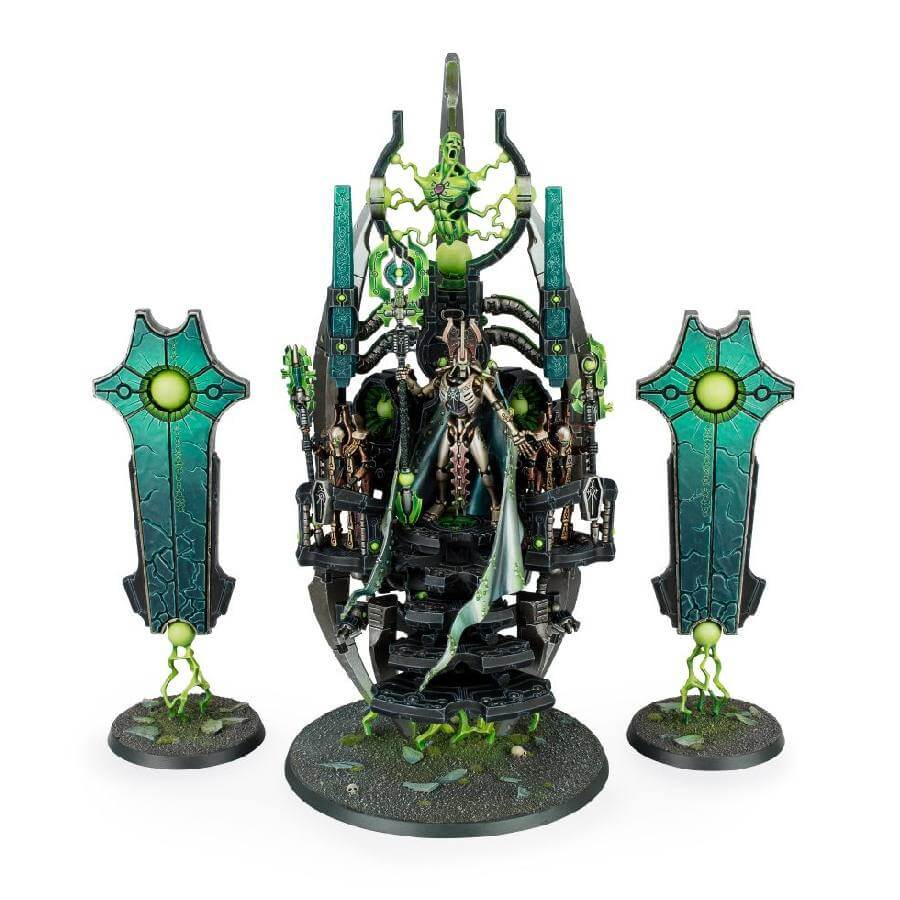
After the Necrons‘ victory and the shattering of the C’tan, Szarekh experienced a profound sense of remorse for what had become of his people—immortal, yes, but at the cost of their very souls.
In an act of penance, he abolished the protocols that bound the Necrons to his command and vanished into the intergalactic void, leaving the Triarch to oversee the great sleep of the Necrons.
During this long stasis, the Triarch’s roles shifted once more; they became the caretakers of the Necron legacy, watching over the slumbering armies and the silent, darkened worlds that housed them.
It was believed that they would awaken their legions when the galaxy was ripe for a new era of Necron dominion, a time that is now at hand with the Silent King’s recent return to the galaxy, heralding a new chapter in the Necron saga.
Notable Dynasties and their Phaerons
The Necron dynasties, each a vast and sprawling empire unto itself, are led by their Phaerons, who hold power that can rival that of the Silent King:
- The Sautekh Dynasty, under the rule of Imotekh the Stormlord, is perhaps the most expansive and militant of these. Imotekh is a grand strategist whose campaigns are brutal displays of might and precision, often leaving worlds stripped bare of life, ready for repopulation by his undying legions. He is both feared and respected, and his goal is nothing less than the reunification of all Necron under his banner.
- Another formidable dynasty is the Mephrit, whose coreward territories are heavily fortified. They are masters of stellar engineering, harnessing the power of stars themselves to craft weapons of immense power. Their Phaeron, known for his ruthlessness, has turned his gaze towards expansion, employing tactics that burn the atmosphere of planets, leaving behind only the charred remains suitable for Necron habitation.
- The Nihilakh Dynasty prides itself on its guardianship of the past, its Phaeron a preserver of history and collector of relics. Nihilakh territories are among the most secure, with each Tomb World a fortress brimming with treasures from aeons past. They are isolationist by nature but will engage in wars of reclamation, fighting not for territory, but for artifacts that hold significance to their lost culture.
- The Novokh Dynasty, bloodthirsty and savage, is a stark contrast to their more calculating kin. They relish in close-quarter combat, their Phaeron leading from the front, a crimson wave of warriors at his back. Their worlds are arenas, and their armies are ever-honed blades, ready to cut down any who stand against the Necron resurgence.
- The Szarekhan Dynasty is the truest remnant of the Silent King’s rule. With the return of Szarekh, they have been thrust into prominence, their Phaeron seen as the de facto leader in the Silent King’s campaign to reforge the Necron empire. They are the standard to which other dynasties are compared, their technology unrivaled, their warriors without peer.
Tomb Worlds and the Awakening
Tomb Worlds are the necropoli of the Necrons, entire planets engineered to preserve the slumbering armies until the galaxy is ready for their return.
These worlds vary in size and might, but all are labyrinths of stasis-crypts and traps, protected by legions of Canoptek constructs and guarded by traps capable of annihilating interlopers.
The awakening of a Tomb World is a carefully orchestrated event, often begun centuries before the Necrons fully stir from their slumber.
The process is overseen by the Triarch Praetorians, who ensure that each world awakens in the correct sequence, and the Necron Overlords, who must prepare their forces for the reconquest of the galaxy.
The awakening is not without its perils. Some worlds have been lost to system failures or the predations of tomb robbers, their occupants never to rise.
Others awaken to find the galaxy changed beyond recognition, necessitating new strategies and alliances. The recently awakened worlds have encountered a galaxy riven by war, a ripe landscape for Necron domination. Some have begun to forge empires anew, while others seek out ancient allies and enemies, rekindling old rivalries and stoking the fires of vengeance that have smoldered for millions of years.
As more awaken, the galaxy shudders at the prospect of a new War in Heaven, this time not against the Old Ones, but against the younger races that have dared to establish their empires amidst the Necrons’ rightful realm.
The awakening is a harbinger of a new age of darkness, as the undying legions of the Necron dynasties march once more.
Necron Technology
Necron technology is a dark fusion of science and sorcery, so advanced it is barely distinguishable from magic to the lesser races of the galaxy.
Their mastery over the physical world is unparalleled, and their weaponry and engines of war are terrifying in their efficiency.
The core of their technological superiority lies in the use of living metal and necrodermis, the foundation of their very beings and structures.
Their armaments, notably the gauss weapons and disintegration rays, embody the nightmarish power to unmake matter at a molecular level.
Moreover, their mastery over faster-than-light travel through inertialess drives and Dolmen Gates allows them to emerge from the depths of space to strike without warning, their fleets undeterred by the vast distances of the cosmos.
Living Metal and Necrodermis
At the heart of Necron technology lies the arcane substance known as living metal or necrodermis. This extraordinary material has regenerative properties, allowing Necron constructs and warriors to self-repair almost any damage sustained in battle, often within moments of it occurring.
It is composed of innumerable nanomachines, each capable of altering its physical properties to adapt to various situations, such as hardening to deflect incoming projectiles or seamlessly knitting together severed limbs.
This same material is used in the construction of their monolithic structures, which can lie in ruins for millennia before reassembling themselves when their masters awaken.
Necrodermis is not just a passive material; it is responsive to the will of its Necron users, capable of morphing into new configurations to create weapons or to spawn chains of lightning that can incinerate flesh and metal alike.
The versatility of living metal is a testament to the Necron’s mastery over the physical universe, making their technology and their immortal legions incredibly resilient.
Gauss Weapons and Disintegration Rays
Necron weaponry, with its capacity to manipulate the fundamental forces of the universe, is a fearsome hallmark of their technological might.
Gauss Weapons, the most pervasive of their armaments, come in various forms: the Gauss Flayer, the standard armament of Necron Warriors, the Gauss Blaster wielded by Immortals for increased potency, and the heavy Gauss Cannon, mounted on Necron vehicles for anti-armor warfare.
Each weapon sends out a stream of green, magnetic energy that interacts with the target at a molecular level, causing it to disassemble into its constituent atoms in a matter of seconds.
Disintegration rays, often seen on Necron Deathmarks and Lychguard, are even more dreaded. These weapons emit focused beams that cause instantaneous molecular destabilization. Upon impact, the target’s atomic structure is violently disrupted, leading to total disintegration. The Disintegration Ray is able to break down the very bonds that hold matter together.
In addition to these, there are other notable examples such as the synaptic disintegrators used by Deathmarks to target and eliminate enemy commanders with lethal precision, and the heavy destroyer’s gauss destructors, which are renowned for their ability to obliterate tanks and fortifications alike.
The Tachyon Arrow, a rare and prized weapon, harnesses the power of a star’s core and can vaporize the mightiest of foes in a single shot.
These myriad weapons, powered by the same eldritch energy, serve as a grim reminder of the Necron’s supremacy in the realm of warfare technology.
FTL Travel: Inertialess Drives and Dolmen Gates
Necron faster-than-light (FTL) travel capabilities are unmatched, primarily due to their inertialess drives. These drives allow their ships to enter and exit real space at will, giving them a tactical mobility that is almost impossible to counter.
Such technology enables them to bypass the traditional limitations of realspace, making conventional tracking methods useless.
The precise mechanics of inertialess drives are a mystery to all but the Necrons themselves, involving principles that defy the known laws of physics and allow for maneuvers that would otherwise tear a conventional ship apart.
Dolmen Gates, on the other hand, are the Necrons’ answer to warp-based travel. These arcane structures, likely reverse-engineered from the Old Ones’ designs, allow Necron ships to access the Webway – a network of extradimensional tunnels that crisscross the galaxy.
Though the Necrons’ use of the Webway is a violent breach rather than the elegant manipulation employed by the Aeldari, it is no less effective.
Dolmen Gates can be unstable and their use can be contested by the denizens of the Webway, but they represent a strategic asset that can turn the tide of a galactic conflict.
The combination of these two FTL methods makes the Necron fleet incredibly versatile. They can strike from the void with no warning, deploying their forces across the galaxy with a speed and precision that leaves their enemies with no time to prepare.
Whether it is a phalanx of Monoliths materializing on a contested world or a Cairn-class Tomb Ship emerging in the heart of a star system, the Necrons can project power across the galaxy almost at will.
This ability to appear anywhere at any time adds a layer of psychological warfare to their already formidable physical presence, as the threat of a Necron invasion becomes a constant and unpredictable possibility.
Necron Society and Culture
The society and culture of the Necrons are as ancient and mysterious as the stars themselves, shaped by countless millennia and the singular event of their transformation into undying metal beings.
This transformation did not merely alter their bodies but also fundamentally changed their societal structure. At the top of this rigid hierarchy sits the ruling class, followed by a complex caste system of nobles, warriors, and artisans.
Their culture, though seemingly monolithic, is influenced by the remnants of religious beliefs centered around the C’tan, the star gods that once led them to glory and damnation.
Among the most revered figures in their culture are the Crypteks, the masterminds of Necron technology and keepers of knowledge that spans the breadth of time and space.
The Necron Hierarchy
The Necron hierarchy is a meticulously structured system of rule and order, with each tier possessing specific roles and responsibilities. Here is an outline of this rigid caste system:
- The Silent King: The ultimate ruler of the Necron race, traditionally the most powerful figure, though currently absent from day-to-day governance.
- The Triarch: Comprised of three Phaerons, this council aids the Silent King in governing the Necron dynasties and enforces his edicts.
- Phaerons: The supreme lords of individual Necron dynasties, each Phaeron commands vast territories and legions of Necrons.
- Overlords: Rulers of Tomb Worlds and sectors within a dynasty, wielding nearly absolute power over their domains.
- Lords: Serving under Overlords, they are often tasked with overseeing specific regions or leading armies into battle.
- Royal Court: A cadre of advisors and elite warriors that includes:
- Nemesors: Generals of the Necron armies, often leading from the front.
- Vargards: The personal bodyguards and trusted lieutenants to Overlords.
- Crypteks: The keepers of technological and arcane knowledge, divided into various disciplines.
- Immortals: The elite soldiers of the Necron military, more autonomous and durable than their warrior counterparts.
- Deathmarks: Assassins and snipers, tasked with eliminating key targets from the shadows.
- Lychguard: The personal guard of the Necron nobility, skilled warriors encased in the finest necrodermis.
- Necron Warriors: The backbone of the Necron military might, numerous but lacking individual will.
- Flayed Ones: Once warriors, now driven by a madness that makes them crave the flesh they no longer possess.
- Canoptek Constructs: Non-sentient automatons that perform maintenance and defense tasks, including:
This hierarchical structure is what allows the Necrons to operate with such chilling efficiency, with every caste and creature playing its part in the grand design of their silent, undying empire.
Religious Beliefs and the C’tan
Before the biotransference, the Necrontyr worshipped the C’tan, powerful star-born entities with the ability to manipulate reality itself. After the transformation, the Necrons recognized the C’tan as their gods, for it was the C’tan who had offered them the chance at immortality.
The C’tan were worshipped and feared in equal measure, their names and aspects reflecting their dominion over various forces of destruction: the Nightbringer brought death, the Deceiver sowed discord, the Void Dragon mastered technology, and many others whose true names are lost to history.
However, after the Necrons rose up against the C’tan and shattered them into countless shards, these deities were reduced to tools and weapons.

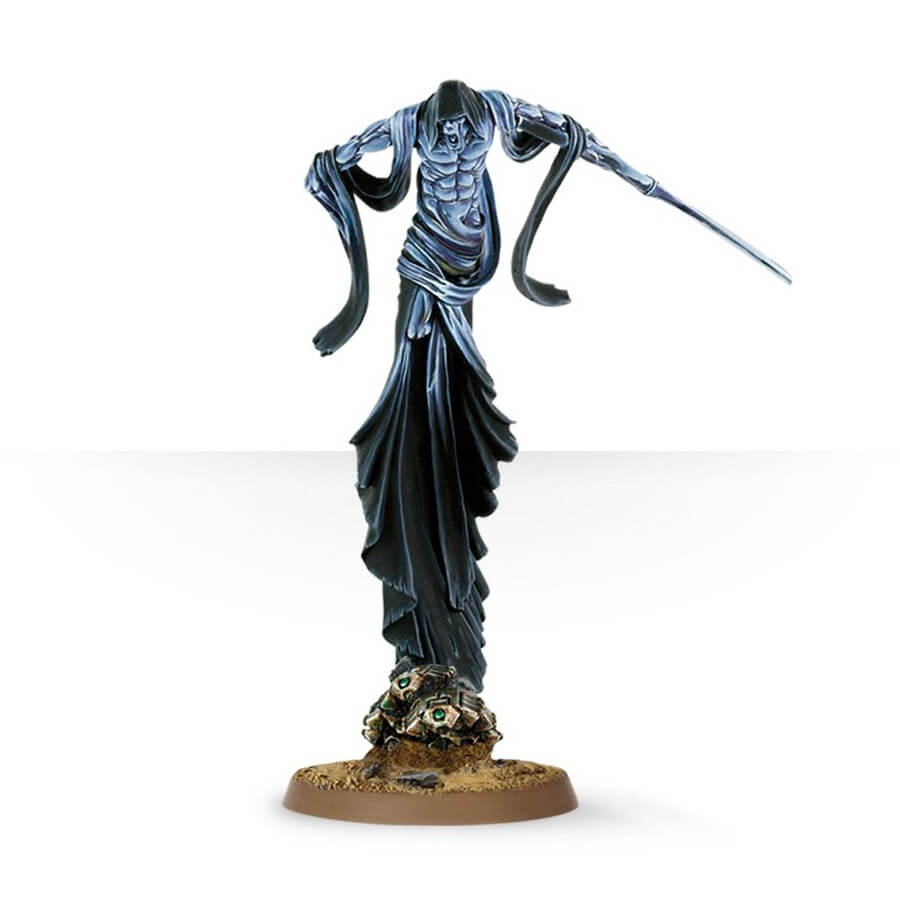
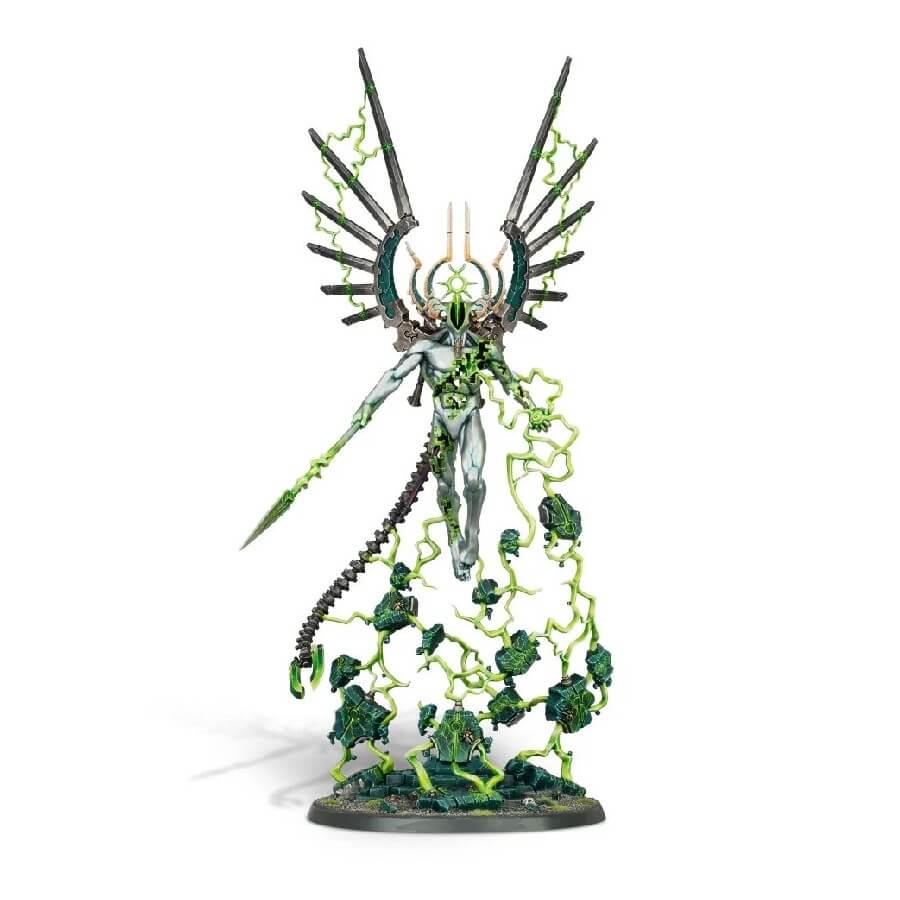
The Necrons’ relationship with their former gods is complex; they are bound to the shards of these entities, using them as weapons or bargaining chips, but they also harbor a deep resentment for the deception that robbed them of their souls.
Some within the Necron ranks still cling to the vestiges of their old faith, a reminder of what they once were and what was taken from them.
Crypteks and Their Arcane Science
Crypteks are the master artificers and techno-sorcerers of Necron society, a caste of scientific practitioners whose knowledge is second only to that of the Silent King himself. They are divided into various disciplines, each specializing in a particular field of Necron science.
The Plasmancers focus on manipulating energy, wielding it as a weapon or a tool. Chronomancers master time, able to manipulate temporal fields to slow foes or hasten allies. Psychomancers delve into the mind, affecting the thoughts and emotions of both the living and the machine. Finally, there are the Harbingers of Destruction, who craft the deadliest weapons of the Necron arsenals.
Their role in society is not only as inventors and keepers of technology; they are also advisors to the nobility, their knowledge often guiding the strategic and political decisions of the dynasties. The Crypteks’ command over arcane science allows the Necrons to traverse stars, regenerate wounds, and wield weapons that can unmake reality, maintaining their status as one of the most advanced races in the galaxy.
Major Conflicts and Campaigns
The Necrons have been at the heart of some of the most cataclysmic events in the galaxy’s history, their actions often serving as the fulcrum upon which the fate of entire species and star systems are turned. These campaigns and conflicts showcase the might and terror of the Necron resurgence and their impact on the galaxy at large.
The Fall of the Aeldari and the Birth of the Eye of Terror
The Fall of the Aeldari was an event of monumental tragedy that reshaped the cosmic landscape, and while the Necrons were not direct participants, the reverberations of this catastrophe were felt even in their stasis tombs.
The Aeldari’s descent into decadence led to the birth of the Chaos God Slaanesh, whose emergence created the Eye of Terror, a massive warp storm that consumed countless Aeldari lives and worlds.
This cataclysm had a significant side effect: the weakening of the barriers between realspace and the warp, which inadvertently hastened the awakening of many Necron Tomb Worlds.
Sensing the galaxy in turmoil, these newly roused Necrons began their campaigns to reconquer the galaxy amid the confusion and terror of the Aeldari’s downfall, exploiting the newly formed vulnerabilities and using the mayhem to their advantage to launch assaults against both Chaos-infested regions and the rump Aeldari domains.
The Orphean War
The Orphean War stands as a stark reminder of the Necron’s destructive potential and their relentless pursuit of dominion. This conflict began when a massive Necron fleet emerged from the Orpheus sector, systematically attacking and overwhelming the Imperial worlds there.
Under the command of the Phaeron known as Amarkun the Gatherer, the Necron onslaught was brutal and efficient, leading to the decimation of Imperial forces and the loss of countless lives.
The Imperial response was significant, marshaling a sizable counter-offensive that included multiple Space Marine chapters and the Imperial Navy.
However, the Necrons’ superior technology and the strategic genius of their undying commanders resulted in a catastrophic defeat for the Imperium.
The Orphean War was a stark demonstration of the Necron ability to wage war and their threat to the stability of the galaxy.
The Szarekhan Dynasty’s Recent Engagements
The Szarekhan Dynasty, perceived as the inheritors of the Silent King’s legacy, has been particularly active in recent times.
With the return of the Silent King to the galaxy, this dynasty has been at the forefront of a series of calculated strikes against both the burgeoning empires of the younger races and the resurgent forces of the Aeldari.
Their engagements have been characterized by the use of overwhelming force, advanced strategy, and new, terrifying forms of warfare.
This includes the deployment of the unearthly C’tan shards, which they wield as weapons of mass destruction against their foes, and the use of esoteric technology that can undo reality itself.
Their recent actions have not only reclaimed long-lost Necron territories but have also sown terror among their enemies, serving as a prelude to what many fear will be a new era of Necron supremacy.
The Silent King’s strategies, as executed by the Szarekhan Dynasty, have rekindled ancient alliances and reignited old wars, with the Necrons emerging as a power that could very well dictate the fate of the galaxy.
Notable Necrons and Heroes
The Necrons have among their number individuals of such power and renown that their very names inspire awe and fear across the galaxy. These figures have shaped Necron history and continue to play pivotal roles in their relentless march across the stars.
Imotekh the Stormlord
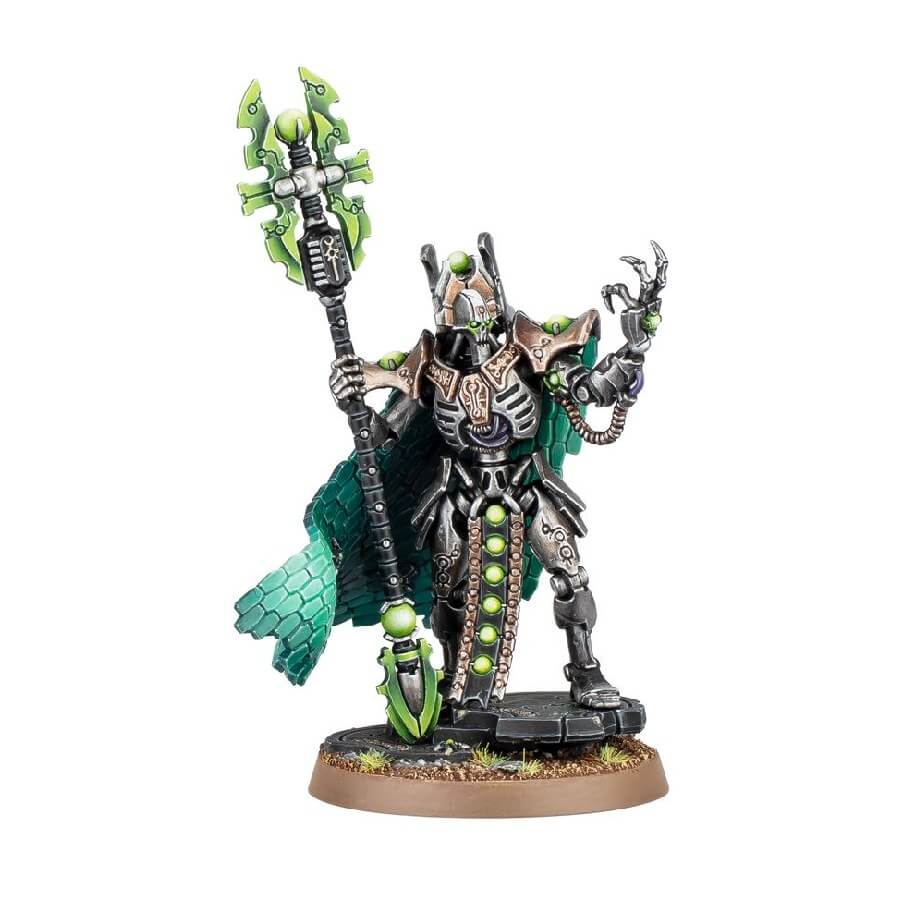
Imotekh the Stormlord, Phaeron of the Sautekh Dynasty, is a master tactician and a warrior without peer. His rise to power was marked by a series of brutal and cunning campaigns that united the fractious Sautekh Dynasty under his iron rule. His strategic genius is such that he has never been defeated in battle, a fact that has earned him the grudging respect of friends and foes alike.
Imotekh is as merciless as he is brilliant, known for his custom of severing the right hands of his defeated foes as trophies.
His most renowned campaign, the Gehenna Massacre, saw the decimation of the Ork empire of Charadon, where he crushed the greenskins with his calculated use of strategy and overwhelming firepower.
Under his command, the Sautekh Dynasty has become the most expansive and aggressive of all the Necron forces in the galaxy, their legions marching forth from the Crownworld of Mandragora to conquer world after world in a seemingly unstoppable tide.
Trazyn the Infinite
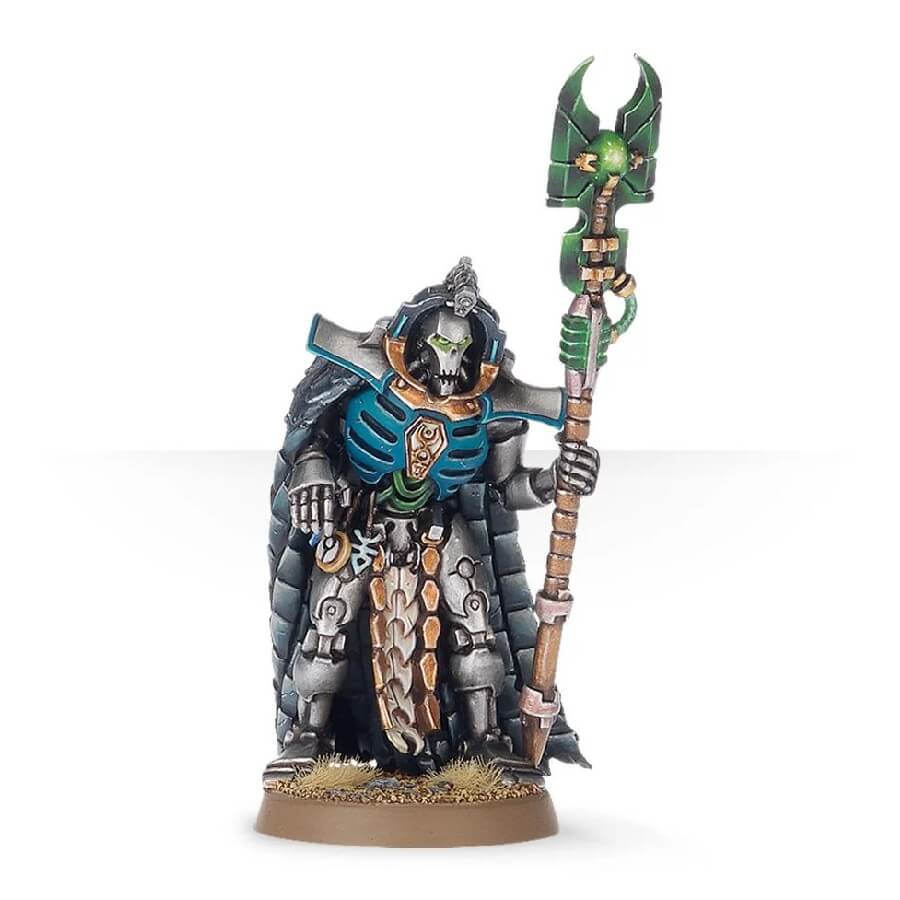
Trazyn the Infinite, the overlord of the Solemnace Dynasty, is as enigmatic as he is infamous. A hoarder of relics and antiquities, Trazyn’s collection includes not only artifacts but also living specimens snatched from the battlefield at the moment of their defeat, preserved forever in stasis for his personal gallery.
His Tesseract Labyrinths, intricate and impossible prisons of living metal, hold heroes from countless races and eras, making his collection as diverse as it is valuable.
Trazyn’s obsession with preservation often leads him to enter conflicts not for conquest, but to acquire new additions for his galleries. He is known to have allied with and betrayed several factions within the galaxy, always with the aim of acquiring what he deems to be worthy of his unending collection.
His most audacious act was during the Fall of Cadia, where he released several of his collected specimens to sow chaos and cover his theft of valuable Blackstone Fortresses.
The Silent King Szarekh

Szarekh, the last of the Silent Kings, is the most legendary figure in Necron history. His rule saw the transformation of the Necrontyr into the Necrons and the subsequent war that led to the enslavement and shattering of the C’tan.
It was Szarekh who, in a moment of horror at what he had done to his people, destroyed the command protocols binding the Necrons to his will, effectively granting them independence before he exiled himself into the intergalactic void.
His millennia-long sojourn saw him encountering the Tyranid threat, a discovery that compelled him to return to the galaxy to rouse his people for a new war, this time not for dominion, but for survival.
The Silent King’s return has heralded a new age for the Necrons, as he seeks to unite the disparate dynasties and lead them against the encroaching darkness of the Tyranids.
Szarekh wields not only supreme command over the Necron legions but also profound knowledge and technology that could turn the tide against the Tyranids and restore the Necrons as the rightful rulers of the galaxy.
His actions are a grand game of cosmic chess, with each move calculated to outmaneuver both the Tyranid hive fleets and the political machinations of the younger races.
Enemies of the Necrons
Throughout the eons, the Necrons have made many enemies, their relentless pursuit of galactic domination bringing them into conflict with numerous races.
Some of these enmities date back to the time of the War in Heaven, while others are more recent, born from the Necrons’ reawakening and the resultant territorial disputes and ideological clashes.
Enduring Enmity with the Eldar
The enmity between the Necrons and the Eldar is as old as the War in Heaven itself, where the Necrons’ star gods, the C’tan, and the Old Ones, creators of the Eldar, fought for supremacy.
The Eldar, crafted as a weapon against the Necrontyr, still harbor a deep-seated hatred for the ancient mechanical race. This ancient grudge has flared up repeatedly as the Eldar view the reawakening of the Necron Tomb Worlds as a dire threat.
The Eldar’s Farseers often foresee conflict with the Necrons and take preemptive steps to thwart their plans. Skirmishes between the Eldar and Necrons are typically high-stakes, with the Eldar seeking to prevent the full reawakening of a Tomb World or to destroy a particularly dangerous piece of Necron technology.
The Eldar’s mastery of the Webway and psychic prowess contrasts sharply with the Necrons’ technological might and strategic acumen, making their conflicts some of the most unpredictable and catastrophic.
Skirmishes with the Imperium of Man
The Imperium of Man, a relatively young empire in the eyes of the Necrons, has become one of their most frequent adversaries.
As the Necrons awaken and expand their territories, they often encounter the zealous forces of the Imperium. These encounters vary from minor skirmishes over frontier worlds to full-scale wars such as the aforementioned Orphean War.
The Imperium’s vast military, led by the Adeptus Astartes and the Imperial Guard, coupled with the zealous fervor of the Adeptus Mechanicus and the Ecclesiarchy, clashes with the cold, calculating legions of the Necrons.
Many battles are fought over worlds that the Imperium has colonized, not knowing that beneath the surface lies a slumbering Necron force. The Necrons view the Imperium’s technology as crude and their belief in the Omnissiah as a perverse shadow of their own machine perfection.
Clashes with the Tyranids and Orks
The Tyranids and Orks represent a different kind of threat to the Necrons, one born not from ancient grudges but from the inherent conflict between diametrically opposed natures.
The Tyranids, a ravenous extragalactic swarm, consume all biomatter in their path, which is anathema to the Necrons’ desire for order and dominion.
Clashes with the Tyranids often occur on worlds that are rich in biological life, strategic locations where the Necrons seek to halt the Tyranid advance and protect their Tomb Worlds from being overrun by the Great Devourer. The Silent King, in particular, sees the Tyranids as the antithesis of everything the Necrons stand for and a cancer that must be excised from the galaxy.
Orks, the ever-warlike and anarchic race, often clash with the Necrons purely by chance, their love for battle driving them to seek out powerful adversaries.
The Orks’ crude yet effective WAAAGHs! frequently stumble upon Necron Tomb Worlds, their belligerence unwittingly awakening the ancient race.
These conflicts are brutal and straightforward, with the Orks’ sheer numbers and ferocity pitted against the advanced weaponry and disciplined ranks of the Necrons.
Each clash with the Orks is a chance for the Necrons to test their martial prowess and to cull the Ork population, preventing them from becoming a larger threat to Necron plans.
Necron Variants and Special Units
The Necron legions are not a monolith but a complex array of specialized units and constructs, each designed for a specific purpose within their military strategy. These variants range from the elite guardsmen to the artificial constructs that patrol their tomb worlds, to the towering engines of destruction that lead their war fleets.
The Lychguard and the Deathmarks
The Lychguard serve as the ultimate protectors of the Necron nobility. Clad in heavy necrodermis armor and wielding hyperphase swords and dispersion shields, they are the elite bodyguards for the highest ranks of the Necron hierarchy, such as Overlords and Phaerons.
Their duty is to safeguard their masters at any cost, and they are imbued with a fanatical loyalty that makes them unyielding in the face of even the most overwhelming odds. Lychguards are often seen in the thick of battle, where their presence is both a morale boost to Necron forces and a harbinger of doom to their enemies.
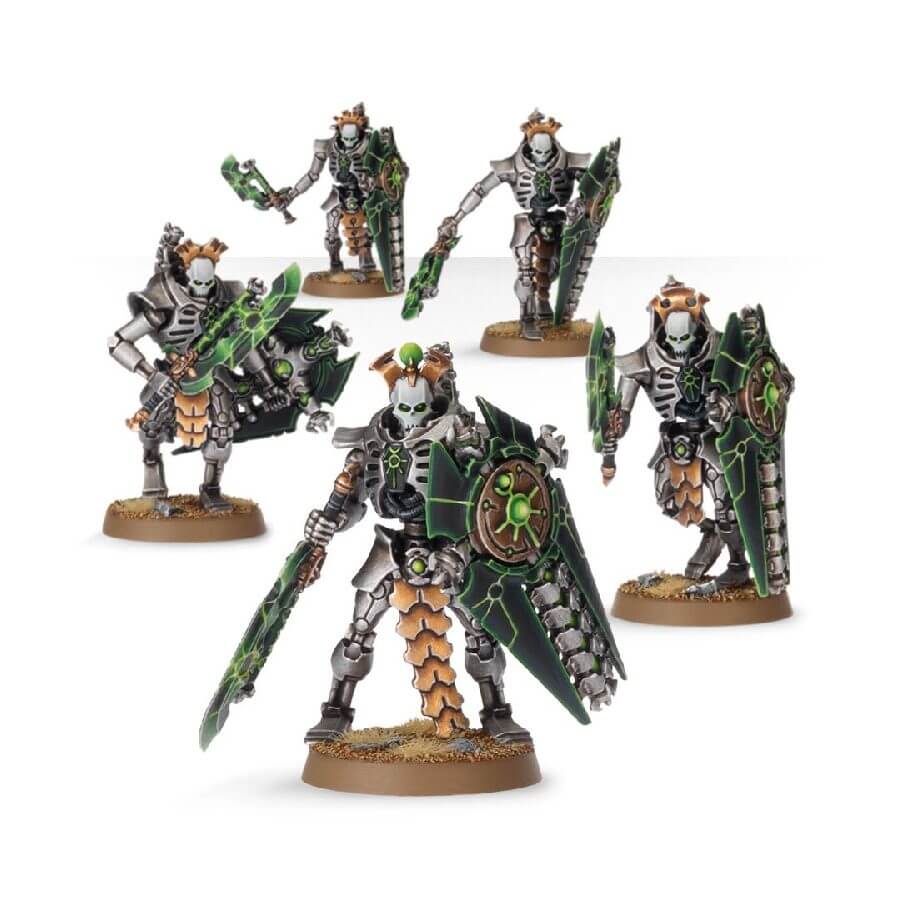
Deathmarks, meanwhile, are the snipers and assassins of the Necron armies. Phasing in from hyperspace at the precise moment to strike, Deathmarks are feared for their ability to target and eliminate key enemy personnel with chilling efficiency.
They bear synaptic disintegrators, weapons that lock onto the life signs of their prey, ensuring that not even the most elusive targets can escape their gaze. Deathmarks often work in silent coordination, appearing unexpectedly to sow chaos and confusion before disappearing as abruptly as they arrived.
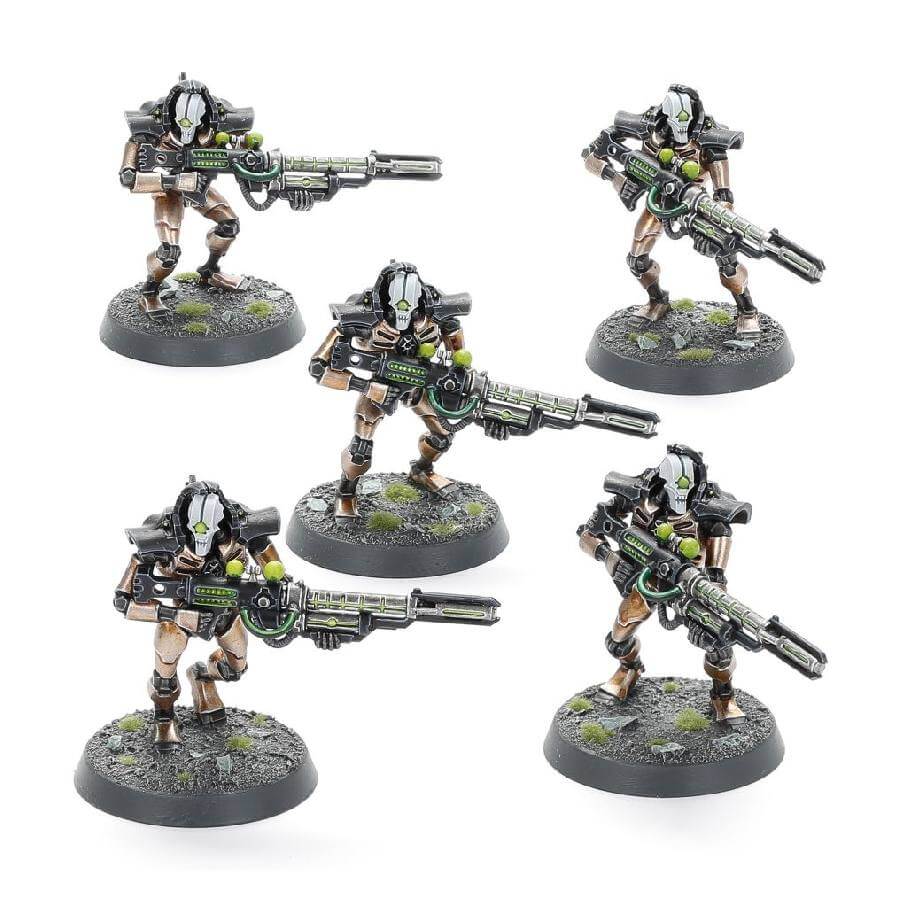
Canoptek Constructs: Wraiths, Scarabs, and Spyders
Canoptek Wraiths are terrifying phantasmal killers, capable of moving through solid objects and striking without warning. Their serpentine bodies are all but immune to conventional weapons, and their vicious claws can rend through armor as if it were mere flesh.
Wraiths are not only combatants but also guardians of the tomb complexes, patrolling for intruders and making swift work of any who dare trespass.
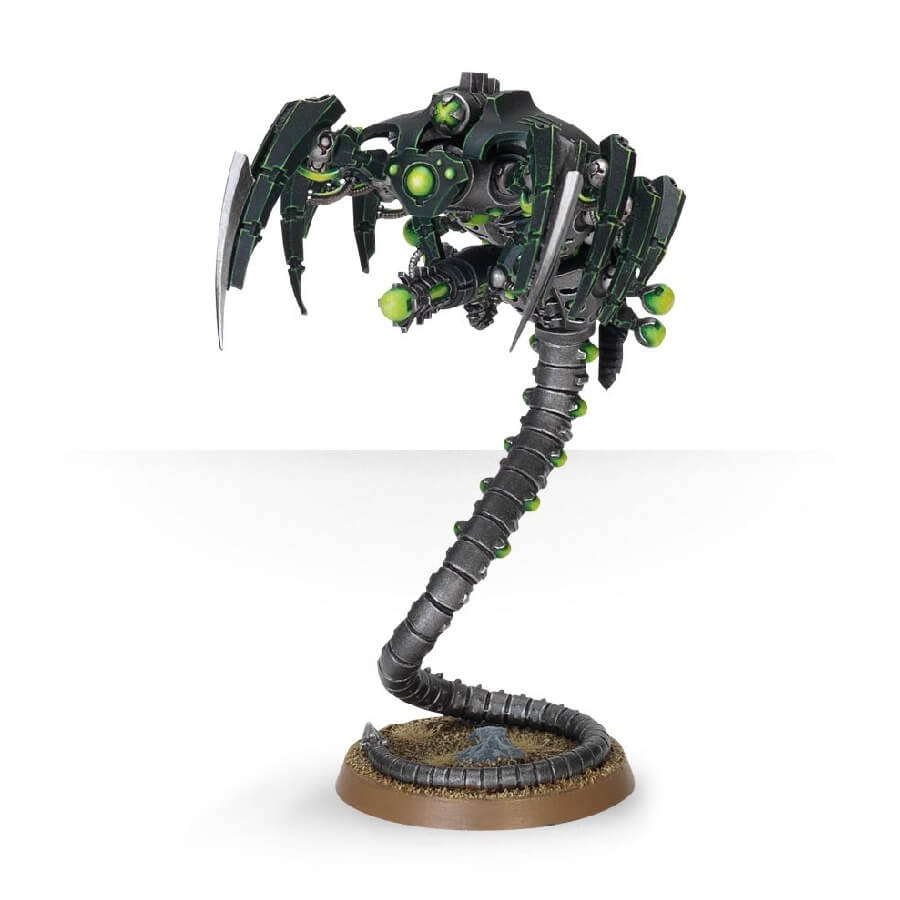
Scarabs are the swarming, insect-like constructs that serve a multitude of purposes within Necron domains.
These skittering hordes can break down matter at a molecular level, scavenging raw materials to repair damaged Necron units or structures, or consuming enemy equipment and even soldiers, rendering them down into their component atoms in moments. Scarabs are often the first sign of a Necron awakening, as they busily prepare the way for their larger kin.
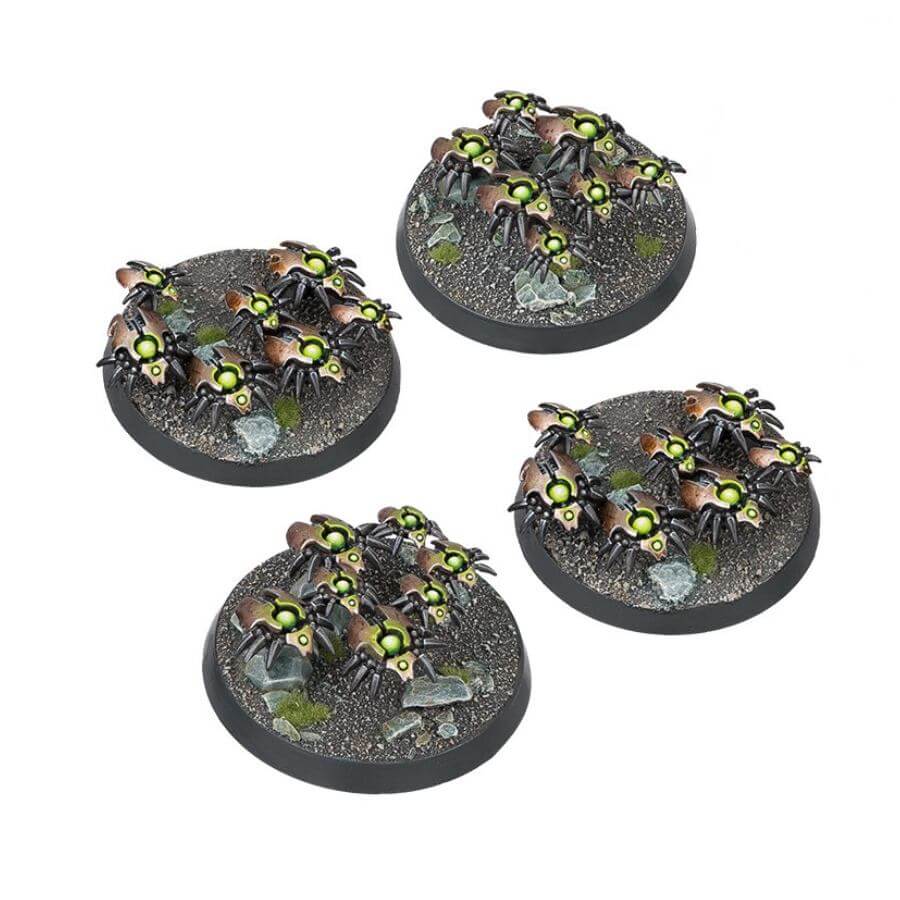
Canoptek Spyders are larger constructs that act as overseers for Scarab swarms and perform more substantial repair tasks.
They are also formidable combatants in their own right, able to unleash destructive energy blasts at their foes or engage in close combat with powerful pincers. Spyders often accompany Necron forces to provide in-the-field repairs, ensuring the relentless advance of the Necron legions.
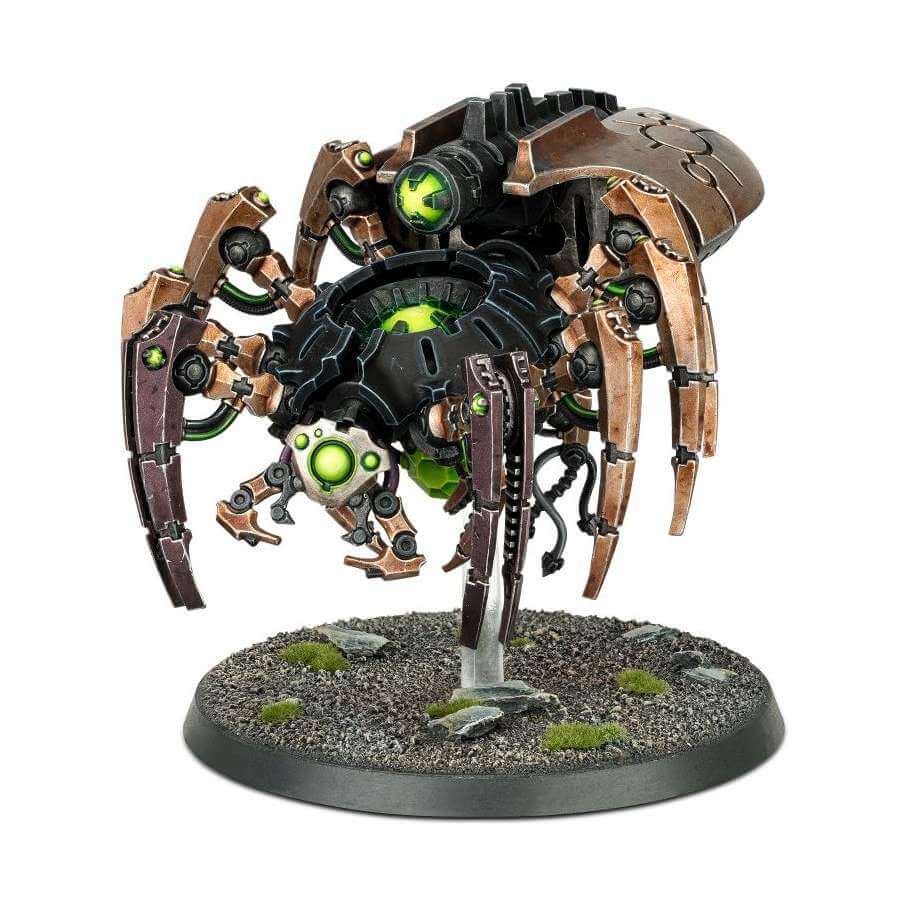
The Monoliths and War Machines of the Necrons
The Monoliths are the cornerstones of the Necron war machine, massive floating fortresses that serve as troop transports, heavy fire support platforms, and symbols of Necron might.
Their armored hides are all but impervious to enemy fire, and they bear weapons that can unleash devastating firepower, such as the particle whip and gauss flux arcs. Monoliths are often the vanguard of a Necron invasion, their arrival heralding the unleashing of waves of Necron warriors from their cavernous holds.
Alongside the Monoliths are other war machines of terrifying power:
- The Doomsday Ark, with its doomsday cannon, is a mobile artillery unit capable of laying waste to entire enemy formations with a single shot.
- The Annihilation Barge, bristling with tesla destructors, crackles with energy that arcs between enemy units, wreaking havoc on tightly packed troops.
Each of these war machines is a marvel of Necron engineering, combining incomprehensible technology with a lethal purpose that reflects the Necron’s single-minded drive towards conquest and reclamation.
Role in the Current State of the Galaxy
The Necrons’ role in the galaxy has grown ever more prominent as they continue to awaken from their eons-long slumber. Their actions and inactions alike have significant implications for the current state of the galaxy, particularly in the wake of recent cataclysmic events.
The Great Rift and the Necrons
The emergence of the Great Rift, a colossal tear in the fabric of reality that has effectively bisected the galaxy, has had profound effects on all who inhabit the Warhammer 40k universe. For the Necrons, this has presented both a challenge and an opportunity.
On one hand, the Rift’s creation has unleashed warp storms that have disrupted Necron dynasties’ communications and navigation, potentially isolating Tomb Worlds from one another. On the other hand, the resulting chaos has weakened many of the Necron’s enemies, leaving them ripe for conquest.
Furthermore, the Necrons possess technology, like the Dolmen Gates, that enables them to bypass the warp’s turmoil, giving them a unique advantage in this new divided galaxy.
Some dynasties have seized this moment to expand aggressively, while others have focused on protecting their domains from the warp’s corrupting influence, deploying pylons that can stabilize or even close warp breaches.
Alliances and Wars in the Age of the Dark Imperium
In the Age of the Dark Imperium, the galaxy has seen the rise of old powers and the fall of established empires. The Necrons, ancient beyond the memory of most, have been forced to navigate this treacherous new landscape.
While they are typically a solitary race, the strategic situation has led some dynasties to form temporary alliances with unlikely factions, such as Imperium forces, to counter common threats like the Tyranids or Chaos incursions.
At the same time, the Necrons have not hesitated to wage wars on multiple fronts, against both old adversaries like the Eldar and new ones like the resurgent forces of the Adeptus Astartes, following the resurrection of the Primarch Roboute Guilliman. These conflicts are not mere skirmishes but pivotal battles that could determine the fate of sectors and the power balance within the galaxy.
Prophecies and the Future of the Necrons
The Necrons are a race steeped in prophecy, with Crypteks and astromancers who can peer into the future’s shifting currents. One such prophecy speaks of the coming of the “Final War,” a conflict that would see the Necrons restore their ancient dominions and eradicate the younger, “lesser” races.
In preparation, the Necrons are reactivating ancient technologies and weapons of mass destruction, such as the Celestial Orrery, a device capable of unmaking stars.
The Silent King’s return is seen as a sign of these end times, and his campaigns are not random acts of conquest but carefully laid plans to position the Necrons as the galaxy’s ultimate power.
The future of the Necrons is tied to their past, their destiny entwined with their will to correct the perceived cosmic imbalance that has allowed lesser races to thrive. As they continue to awaken, gathering strength and resources, the galaxy must brace for the impact of a race as relentless in pursuit of their goals as time itself.
Glossary of Terms
- Aeldari (Eldar): An ancient and highly psychic race that once dominated the galaxy before the rise of the Necrons and humanity.
- Biotransference: The process by which the Necrontyr transferred their consciousness into immortal metal bodies, becoming the Necrons.
- C’tan: Star gods that fed on the living energies of the Necrontyr, later shattered into shards by the Necrons after being used to defeat the Old Ones.
- Cryptek: A member of the Necron techno-sorcerous elite, skilled in the arts of reanimation and other arcane sciences.
- Dolmen Gates: Arcane constructs that allow the Necrons to breach the Webway and travel across the galaxy.
- Flayed Ones: Necrons afflicted with a madness that drives them to adorn themselves with the flesh of their enemies.
- Gauss Weapons: The primary armaments of the Necrons, capable of stripping a target to atoms.
- Great Rift: A vast warp storm that has split the galaxy in half, also known as Cicatrix Maledictum.
- Immortals: Elite Necron warriors, more resilient and heavily armed than basic Necron Warriors.
- Inertialess Drive: A method of Necron FTL travel that negates inertia, allowing for near-instantaneous movement across space.
- Lychguard: The elite personal guard of Necron nobility, armed with hyperphase swords and dispersion shields.
- Monolith: A massive Necron war machine that serves as a transport, a heavy weapons platform, and a symbol of their might.
- Necrodermis: The living metal that makes up the bodies of the Necrons and their structures.
- Necrontyr: The original race that the Necrons were before they underwent biotransference.
- Overlord: A high-ranking Necron noble that rules over a Tomb World or sector.
- Phaeron: The ruler of an entire Necron Dynasty.
- Silent King: The last and the highest authority of the Necron race, traditionally the ruler of all Necrons.
- Tomb World: A planet that houses the sleeping Necron armies and their catacombs.
- Triarch: A council of three powerful Necrons who assist the Silent King in ruling the Necron empire.
- War in Heaven: The ancient galactic conflict between the Necrontyr (and later the Necrons) and the Old Ones, exacerbated by the C’tan.
- Webway: An ancient network of extradimensional pathways created by the Old Ones and later partially accessed by the Necrons via Dolmen Gates.
Timeline of Major Events in Necrons Lore
- Pre-War in Heaven: The Necrontyr civilization arises. This event is set in a period long before most of the known Warhammer 40,000 history, likely several million years before the current setting of the 41st millennium.
- War in Heaven: The Necrontyr wage war against the Old Ones. This war is one of the earliest and most significant events in the Warhammer 40k lore, believed to have occurred millions of years before the current era.
- Biotransference: The Necrontyr transfer their consciousness into metal bodies, becoming the Necrons. This event is closely tied to the War in Heaven, so it also dates back several million years.
- Rebellion Against the C’tan: This event occurs shortly after the biotransference, as the Necrons turn against the C’tan and shatter them into shards. It’s still within the timeframe of several million years ago.
- The Great Sleep: The Necrons enter into a state of hibernation. This period marks a long gap in their history, spanning until the late 41st millennium.
- Awakening: The Necrons begin to awaken from their slumber. This event is set in the 41st millennium, around the time of the current Warhammer 40,000 setting. Specific triggers like the Fall of the Aeldari and the birth of the Eye of Terror are key events in the 40k timeline, occurring in M29 and M31, respectively.
- The Orphean War: This is a more recent event in the 40k timeline, occurring in the late 41st millennium.
- The Great Rift Opens: This event, also known as the Cicatrix Maledictum, occurs in the 41st millennium, specifically in the year 999.M41, leading to the current “Dark Imperium” era in the game’s lore.
- The Silent King Returns: Szarekh’s return marks a new phase in Necron activity and is set in the 41st millennium, closely following the opening of the Great Rift.
Recommendations for Further Reading
For those seeking to delve deeper into the lore of the Necrons and the broader Warhammer 40,000 universe, the following sources are highly recommended:
- Codex: Necrons (latest edition): The definitive sourcebook for all things Necron, including detailed descriptions of their history, hierarchy, and units.
- “The Infinite and The Divine” by Robert Rath: A novel that provides a deeper look into Necron culture through the eyes of Trazyn the Infinite and Orikan the Diviner.
- “The Everliving Legion” (Anthology): A collection of stories about the Necrons, offering various insights into their society and their war with other races.
- “The World Engine” by Ben Counter: A novel that focuses on the Necrons’ clash with the Space Marines as they try to reactivate a planet-sized war machine.
- Warhammer 40,000 Core Rulebook (latest edition): Provides an overview of the Warhammer 40,000 universe, including the place of the Necrons within the current state of the galaxy.
- Black Library Website: The publishing arm of Games Workshop, which offers a wide range of novels, novellas, and audio dramas set in the Warhammer 40,000 universe.
These resources offer a wealth of information and narrative depth that can further enrich one’s understanding of the Necrons’ complex and enigmatic nature.
You made it this far… Congrats!
The Necrons, with their enigmatic past and relentless pursuit of galactic dominance, continue to be a force of immeasurable power and ancient terror in the Warhammer 40,000 universe.
Through understanding the Necrons, one gains insight into the intricate tapestry of the Warhammer 40,000 mythos—a narrative woven with the threads of countless races, each vying for survival and supremacy in a galaxy rife with war and darkness.
As the Necrons awaken from their tomb worlds, the galaxy trembles. Their indomitable will, undying legions, and superior technology make them not just a relic of the past but a pivotal player in the future’s unfolding drama.
Their dynasties rise once more, their silent marches echoing through the void, and their ancient rulers set their gaze upon a universe that has long forgotten the terror of their rule. But the Necrons remember, and they will not rest until all is as it once was, under the cold and deathless dominion of their star-spanning empire.
This guide concludes here, but the story of the Necrons is far from over. It is a narrative continuously expanding through the rich lore of the Warhammer 40,000 universe, where every battle is a verse, and every campaign a chapter in the grand saga of the Necrons.

